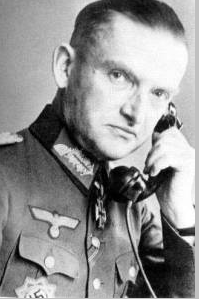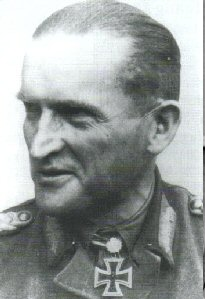Decker, Karl Gustav Adolf
- Date of birth:
- November 30th, 1897 (Borntin/Pommerania, Germany)
- Date of death:
- April 21st, 1945 (Groß-Brunsrode/Lower Saxony, Germany)
- Nationality:
- German
Biography
In service from August 3rd 1914. Committed suicide. Was recommended to receive the Eichenlaub mit Schwertern to the Ritterkreuz. Up till now no formal confirmation of any awaridng has ever been found.
08.05.1915: Fähnrich
12.07.1915: Leutnant
31.07.1925: Oberleutnant
01.05.1931: Rittmeister
01.03.1936: Major
01.04.1939: Oberstleutnant
01.02.1942: Oberst
01.12.1943: Generalmajor
01.06.1944: Generalleutnant
27.12.1944: General der Panzertruppe
Son to an officer lived in Borntin in Pomerania.
03.08.1914: joined the military service and sent to East Prussia
Soon promoted to an officer candidate for bravery before the enemy
1915: fought in Poland, Russia and Courland (now Latvia)
1916: served as Zugführer (platoon leader) of a machine gun unit after he was transferred to the Feldkriegsschule of the German 8th Army
04.1917: transferred to the Western Front and fought in the Battle of Lys where his division suffered heavy casualties
1917: Leutnant and battalion adjutant
1918: weapons instructor assigned to the Infantry School in Döberitz
1920: accepted into the Reichswehr and served with the 29th Reserve Jäger Regiment, the 5th Jäger Regiment and the 6th cavalry Regiment
He was promoted to Oberleutnant and Rittmeister during these assignments in 1925 and 1931.
1936: Major, he was transferred to the staff of the 5th Cavalry Regiment together with Horst Niemack.
Shortly afterwards, he was reassigned again, this time to the 38th Armoured Detachment in Mühlhausen. He later became the commanding officer of this unit.
1939: his unit was subordinated to the 2nd Panzer division during the Invasion of Poland and fought under the command of Decker near Kraków and the Jablonka Pass.
1940: during the Battle of France, Decker commanded a battalion of the 3rd Panzer regiment in the 2nd Panzer division. This unit fought at the Maas, near Sedan, Saint-Quentin and Abbeville.
1941: in Balkans Campaign, his regiment fought in Yugoslavia, northern Greece, occupied Athens and crossed the Corinth Canal. 05.1941: put in command of 3rd Panzer regiment for Operation Barbarossa
04.1942: transferred to the staff of the 9th Army
04.1943: appointed commander of the 5th Panzer Division
04.05.1944: received the Oak Leaves to the Knight's Cross and promoted to Generalleutnant.
01.01.1945: appointed commander of the XXXIX Panzer Corps that was attached to the 3rd Panzer Army and promoted to General der Panzertruppe
After his unit was relocated to the Western Front, his corps fought the Americans at Uelzen and in the Alsace. Here the 5th Panzer Army was subordinated to Army Group B.
21.04.1945: committed suicide after the defeat and encirclement of the Army Group in the Ruhr Pocket in April.
Do you have more information about this person? Inform us!
- Period:
- Second World War (1939-1945)
- Awarded on:
- September 27th, 1939
Had already received the Iron Cross 2nd Class on June 22nd 1915.
- Period:
- Second World War (1939-1945)
- Awarded on:
- November 20th, 1939
Had already received the Iron Cross 1st Class on November 1st 1916.
- Period:
- Second World War (1939-1945)
- Rank:
- Oberstleutnant (Lieutenant-colonel)
- Unit:
- Kommandeur, I. Kompanie, Panzer-Regiment 3, 2. Panzer-Division, XVIII. Armee-Korps, 12. Armee
- Awarded on:
- June 13th, 1941
“On the 18.04.1941 Oberstleutnant Decker distinguished himself while leading at the head of Kampfgruppe Balck. He and his troops crossed over the Pinios, broke through the Australian/New Zealanders’ fortified line, thrusted towards Larissa and thereby forced the enemy to give up their Olympus position. By smashing the Yugoslavian defense in the Strumica basin he created the necessary conditions for the 2. Panzer-Division’s thrust to Salonika.”
306th Award.
Submitted on June 3rd 1941.
Preliminary document and decoration on June 17th 1941 to stellv. VII. AK.
- Period:
- Second World War (1939-1945)
- Rank:
- Oberst (Colonel)
- Unit:
- Kdr, Panzer-Regiment 3, 2. Panzer-Division
- Awarded on:
- August 1st, 1942
Award 154/1
- Period:
- Second World War (1939-1945)
- Rank:
- Generalmajor (Brigadier)
- Unit:
- Kdr, 5. Panzer-Division
- Awarded on:
- December 11th, 1943
- Period:
- Second World War (1939-1945)
- Rank:
- Generalmajor (Brigadier)
- Unit:
- Kdr, 5. Panzer-Division
- Awarded on:
- March 2nd, 1944
- Period:
- Second World War (1939-1945)
- Rank:
- Generalmajor (Brigadier)
- Unit:
- Kommandeur, 5. Panzer-Division, LVI. Panzer-Korps, 2. Armee, Heeresgruppe Mitte
- Awarded on:
- May 4th, 1944
“For the outstanding leadership of the 5. Panzer-Division north of Rogatschew in the time period 22.02.-21.03.1944 and the subsequent relief battles at Kovel. On the morning of the 05.04.1944 contact was established with an outermost strongpoint of Fortress Kovel; the villages of Dubowa and Rudniki (northwest of the city) were taken.”
The following press article, dated 08.05.1944, provides further details as to these actions…
“At the end of February 1944 the Soviets achieved a penetration north of Rogatschew, and in response the 5. Panzer-Division was thrown into battle in a piecemeal fashion as soon as each Bataillon arrived. In order to buy time for the arrival of further forces Generalmajor Decker created a thin, strongpoint-like defensive front that initially halted the enemy advance. However on the next day the Soviets attacked the weak elements of the 5. Panzer-Division with 3 of their own divisions. They launched an enveloping thrust through a gap in the German frontline with strong forces and proceeded to a key German position along the Pruth river. To deal with this the divisional commander rushed to the threatened site with a handful of reserves, a few heavy Pak guns and a Kompanie of Pioniere. He set up a defense just before the Soviets arrived and in the ensuing battle, during which he personally fought in the foremost line and positioned the Paks, he and his men defeated all enemy attacks until the arrival of friendly reinforcements. A few days later, on the 02.03.1944, the Wehrmachtbericht reported that in this fighting the Silesian 5. Panzer-Division under the command of Generalmajor Decker had outstandingly acquitted itself. This was the second time within three months that Generalmajor Decker and his Division had been named in the Wehrmachtbericht.”
466th Award.
Submitted on April 24th 1944.
- Period:
- Second World War (1939-1945)
- Rank:
- Generalleutnant (Major-general)
- Unit:
- Kdr, 5. Panzer-Division
- Awarded on:
- August 5th, 1944
- Period:
- Second World War (1939-1945)
- Rank:
- Generalleutnant (Major-general)
- Unit:
- Kdr, 5. Panzer-Division
- Awarded on:
- October 12th, 1944
- Period:
- Second World War (1939-1945)
- Awarded on:
- June 1st, 1940
- Period:
- Second World War (1939-1945)
- Awarded on:
- July 15th, 1942
- Period:
- Second World War (1939-1945)
- Awarded on:
- June 26th, 1940
- Period:
- Second World War (1939-1945)
- Awarded on:
- 1934
- Period:
- Second World War (1939-1945)
- Awarded on:
- November 1st, 1916
- Period:
- Second World War (1939-1945)
- Awarded on:
- June 22nd, 1915
- Period:
- Second World War (1939-1945)
- Awarded on:
- December 20th, 1917
- Period:
- Second World War (1939-1945)
- Awarded on:
- November 2nd, 1943
- Period:
- Second World War (1939-1945)
- Awarded on:
- October 2nd, 1936
- Period:
- Second World War (1939-1945)
- Awarded on:
- October 2nd, 1936
- Period:
- Second World War (1939-1945)
- Awarded on:
- October 2nd, 1936
- Period:
- Second World War (1939-1945)
- Awarded on:
- August 3rd, 1939
Sources
- Photo 1:
- Photo 2:
- Photo: Wilco Vermeer collection, the Netherlands
- - FEDERL, CH., Die Ritterkreuzträger der Deutschen Panzerdivisionen 1939-1945, VDM Heinz Nickel, Zweibrücken, 2000.
- PATZWALL, K. & SCHERZER, V., Das Deutsche Kreuz 1941-1945, Band II, Verlag Klaus D. Patzwall, Norderstedt, 2001.
- WEGMANN, GüNTER, Die Ritterkreuzträger der Deutschen Wehrmacht 1939-1945, Biblio-Verlag, 2004.
- Die Ordensträger der Deutschen Wehrmacht (CD), VMD-Verlag GmbH, Osnabrück, 2002
- Kwasny A., Kwasny G., Die Eichenlaubträger 1940-1945 (CD), Deutsches Wehrkundearchiv, Lage-Waddenhausen, 2001
- TITLE





















